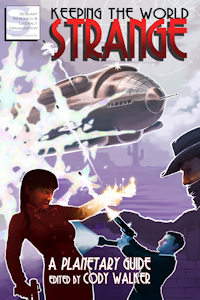Peter Sanderson
BOOKS AND MOVIES BY PETER SANDERSON
 Keeping the World Strange: A Planetary Guide (contributor) |  Gotham City 14 Miles: 14 Essays on Why the 1960s Batman TV Series Matters (contributor) |  Minutes to Midnight: Twelve Essays on Watchmen (contributor) |
MAGAZINE CONTENT BY PETER SANDERSON (15 TOTAL)
 1986: D.P.7 — Reality Vs. Fantasy
1986: D.P.7 — Reality Vs. Fantasy
The previous installment recounted how in the landmark year of 1986, Marvel and editor in chief Jim Shooter introduced the New Universe, a new fictional reality, that was intended to be a more realistic setting… [more]
 1986: D.P.7 — Group Therapy for Superhumans
1986: D.P.7 — Group Therapy for Superhumans
In 1986, twenty-five years after the publication of Fantastic Four #1, which launched the modern Marvel Universe, Marvel editor in chief Jim Shooter introduced a new fictional reality in Marvel Comics, the New Universe. This… [more]
 1986: The British Invasion, Part 3: Neil Gaiman & Swamp Thing
1986: The British Invasion, Part 3: Neil Gaiman & Swamp Thing
One of the most important effects that Alan Moore had on the history of comics was triggering the entrance of Neil Gaiman into the medium. Gaiman had given up reading comics when he was sixteen… [more]
 1986: The British Invasion, Part 2: Grant Morrison in 1986: Superman & Captain Britain
1986: The British Invasion, Part 2: Grant Morrison in 1986: Superman & Captain Britain
The last installment examined Grant Morrison’s early, partly comedic Batman prose story, “The Stalking,” which was published in the United Kingdom in 1986. In the 1986 British Superman Annual Grant Morrison did another text story,… [more]
 1986: The British Invasion, Part 1 — Grant Morrison in 1986: Batman
1986: The British Invasion, Part 1 — Grant Morrison in 1986: Batman
As shown in previous installments, in the mid-1980s there were notable late works by two of the leading members of the founding generation of comic book professionals, Will Eisner and Jack Kirby. This period is… [more]
 1986: Strikeforce: Morituri, Part 2: No Way Out
1986: Strikeforce: Morituri, Part 2: No Way Out
In Strikeforce: Morituri, the Marvel Comics series created by writer Peter B. Gillis and artist Brent Anderson, which debuted towards the end of 1986, the Earth of the late 21st century is under attack by… [more]
 1986: Strikeforce: Morituri: We Who are About to Die
1986: Strikeforce: Morituri: We Who are About to Die
In many of the great comics of the year 1986, their creators were examining the medium and the genre in which they were working and their histories, critically reevaluating them and redefining them for a… [more]
 1986: Will Eisner on Old Age (Part 2)
1986: Will Eisner on Old Age (Part 2)
In the final issue of Will Eisner’s Quarterly, published in 1986, Eisner wrote and drew three comics stories that each deal with a protagonist in the last decades of his life. In the previous installment,… [more]
 1986: Will Eisner on Old Age (Part 1)
1986: Will Eisner on Old Age (Part 1)
Towards the end of The Hunger Dogs, Jack Kirby, a longtime veteran creator of comics, turned his attention to the oldest members of his cast: the evil Darkseid, who is finally toppled from power, and… [more]
 The Older Generation’s Farewell: The Hunger Dogs (Part 4)
The Older Generation’s Farewell: The Hunger Dogs (Part 4)
As Jack Kirby’s The Hunger Dogs draws to its close, the arcs of two of its major characters, Orion and Esak, are resolved, as shown in the previous installment.
 The Older Generation’s Farewell: The Hunger Dogs (Part 3)
The Older Generation’s Farewell: The Hunger Dogs (Part 3)
As we have seen, in The Hunger Dogs, the graphic novel in which Jack Kirby resolved his “Fourth World” saga, Kirby’s optimistic vision of the early 1970s turned dark and ominous.
 The Older Generation’s Farewell: The Hunger Dogs (Part 2)
The Older Generation’s Farewell: The Hunger Dogs (Part 2)
From the start of Jack Kirby’s The Hunger Dogs, a new age had arrived.
 The Older Generation’s Farewell: The Hunger Dogs (Part 1)
The Older Generation’s Farewell: The Hunger Dogs (Part 1)
To examine how comics changed in 1986, we should begin by looking at what comics were like in 1985.
 1986, The Year That Changed Comics: Introduction, Part 2
1986, The Year That Changed Comics: Introduction, Part 2
Over the course of the coming months, Sequart will be serializing chapters from my forthcoming book, currently titled 1986: The Year That Changed Comics, here on their website.
 1986, The Year That Changed Comics: Introduction
1986, The Year That Changed Comics: Introduction
In discussions of graphic novels, three works that are regularly cited as landmarks of the medium are Alan Moore and Dave Gibbons’s highly acclaimed Watchmen, Art Spiegelman’s Pulitzer Prize-winning Maus, and Frank Miller’s Batman: The… [more]


















































